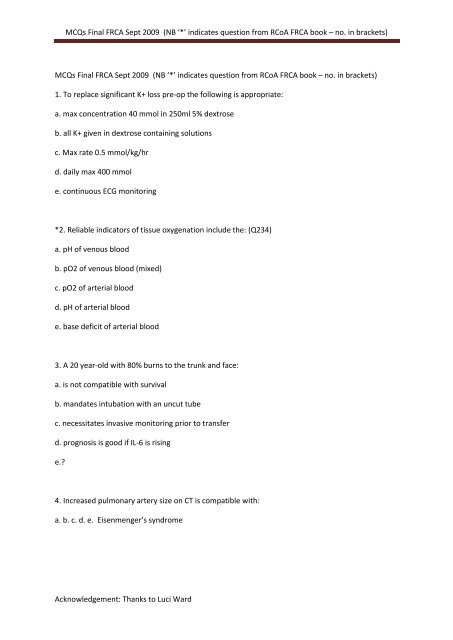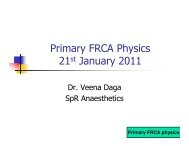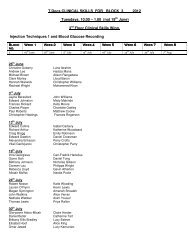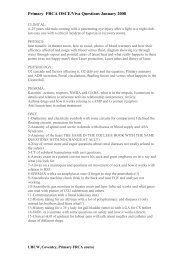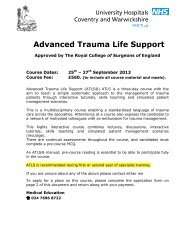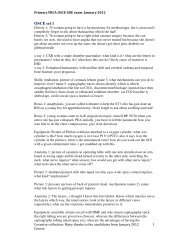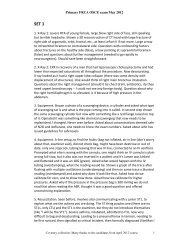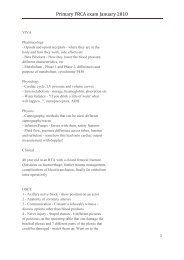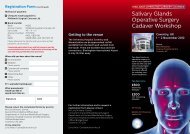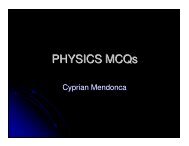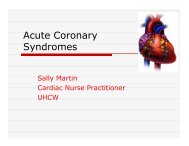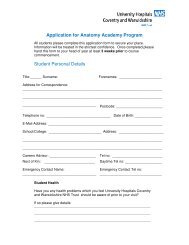MCQs Final FRCA Sept 2009 (NB '*' indicates question from RCoA ...
MCQs Final FRCA Sept 2009 (NB '*' indicates question from RCoA ...
MCQs Final FRCA Sept 2009 (NB '*' indicates question from RCoA ...
- No tags were found...
Create successful ePaper yourself
Turn your PDF publications into a flip-book with our unique Google optimized e-Paper software.
<strong>MCQs</strong> <strong>Final</strong> <strong>FRCA</strong> <strong>Sept</strong> <strong>2009</strong> (<strong>NB</strong> ‘*’ <strong>indicates</strong> <strong>question</strong> <strong>from</strong> <strong>RCoA</strong> <strong>FRCA</strong> book – no. in brackets)<strong>MCQs</strong> <strong>Final</strong> <strong>FRCA</strong> <strong>Sept</strong> <strong>2009</strong> (<strong>NB</strong> ‘*’ <strong>indicates</strong> <strong>question</strong> <strong>from</strong> <strong>RCoA</strong> <strong>FRCA</strong> book – no. in brackets)1. To replace significant K+ loss pre-op the following is appropriate:a. max concentration 40 mmol in 250ml 5% dextroseb. all K+ given in dextrose containing solutionsc. Max rate 0.5 mmol/kg/hrd. daily max 400 mmole. continuous ECG monitoring*2. Reliable indicators of tissue oxygenation include the: (Q234)a. pH of venous bloodb. pO2 of venous blood (mixed)c. pO2 of arterial bloodd. pH of arterial bloode. base deficit of arterial blood3. A 20 year-old with 80% burns to the trunk and face:a. is not compatible with survivalb. mandates intubation with an uncut tubec. necessitates invasive monitoring prior to transferd. prognosis is good if IL-6 is risinge.?4. Increased pulmonary artery size on CT is compatible with:a. b. c. d. e. Eisenmenger’s syndromeAcknowledgement: Thanks to Luci Ward
<strong>MCQs</strong> <strong>Final</strong> <strong>FRCA</strong> <strong>Sept</strong> <strong>2009</strong> (<strong>NB</strong> ‘*’ <strong>indicates</strong> <strong>question</strong> <strong>from</strong> <strong>RCoA</strong> <strong>FRCA</strong> book – no. in brackets)5. Venous air embolism is dangerous because:a.b. Because 25% of population have patent foramen ovalec. Bubbles may be small enough to reach left heart via pulmonary capillariesd. May occlude pulmonary outflow tracte.?6. Student’s t-test:a.b. compares the means of 2 small samplesc.d. reaches significance at p < 0.01e. can be used on non-parametric data*7. The following would cause a rise in sJO2 during GA for intracranial surgery with inducedhypotension: (Q26)a. increased alveolar isoflurane concentrationb. hypocarbiac. pyrexiad. sodium nitroprusside intoxicatione. fentanyl8. Myasthenic syndrome (ie neoplastic-related) in contrast to myasthenia gravis:a. shows poor response to neostigmineb. involves failure of pre-synaptic ACh releasec. shows resistance to non-depolarising NMBDsd. causes mainly proximal muscle weaknessAcknowledgement: Thanks to Luci Ward
<strong>MCQs</strong> <strong>Final</strong> <strong>FRCA</strong> <strong>Sept</strong> <strong>2009</strong> (<strong>NB</strong> ‘*’ <strong>indicates</strong> <strong>question</strong> <strong>from</strong> <strong>RCoA</strong> <strong>FRCA</strong> book – no. in brackets)e. shows sensitivity to suxamethonium9. Regarding Sugammadex and neuromuscular junction blocking drugs:a. Sugammadex only reverses bisquaternary steroid-based NMBDsb. Sugammadex only reverses rocuronium and vecuroniumc. rocuronium is a bisquaternary aminosteroid NMBDd. rocuronium has a faster onset than vecuroniume. rocuronium lasts longer than vecuronium in equipotent doses10. In the treatment of anaphylaxis in adults the following is appropriate:a. 0.5ml 1 in 1000 adrenaline i.m.b. 0.1mg i.v. adrenalin at 1 minute intervalsc. 10ml 10% calcium gluconate i.v.d. nebulised or i.v. salbutamole. ?11. During one-lung anaesthesia, treat hypoxaemia by:a. PEEP to the non-dependent lungb. CPAP to the non-dependent lungc. insufflate O2 into the dependent lungd. clamp pulmonary artery of the dependent lunge. increase respiratory rate to the dependent lung12. Neurofibrmatosis is associated with:a. Thyrotoxicosisb. Gliomatac. ParaplegiaAcknowledgement: Thanks to Luci Ward
<strong>MCQs</strong> <strong>Final</strong> <strong>FRCA</strong> <strong>Sept</strong> <strong>2009</strong> (<strong>NB</strong> ‘*’ <strong>indicates</strong> <strong>question</strong> <strong>from</strong> <strong>RCoA</strong> <strong>FRCA</strong> book – no. in brackets)13. Transfusion of the wrong unit of packed cells can be diagnosed by:a. drop in haematocritb. myoglobinuriac. low haptoglobin??14. Obstruction of the common bile duct causes:a. increased Alkaline Phosphataseb. increased ALTc. increased urobilinogend. steatorrhoea15. In an adult with pyloric stenosis, the following may occur:a. serum sodium 125b. serum bicarbonate 40c. serum chloride 10516. Regarding a eutectic mixture:a. local anaesthetic toxicity is more likelyb. EMLA contains 5% lignocaine and 5% prilocainec. freezing/boiling/melting point is lower17. With regards to use of a cryoprobe:a. adiabatic change occursb. nerve destruction is permanentc. intracellular freezing occursAcknowledgement: Thanks to Luci Ward
<strong>MCQs</strong> <strong>Final</strong> <strong>FRCA</strong> <strong>Sept</strong> <strong>2009</strong> (<strong>NB</strong> ‘*’ <strong>indicates</strong> <strong>question</strong> <strong>from</strong> <strong>RCoA</strong> <strong>FRCA</strong> book – no. in brackets)d. temperature is 237 degrees Kelvin18. Deep somatic pain:a. Cannot radiate elsewhereb. can be relieved by trigger point injection19. Classical TENS via the Gate Theory mechanism is intended to:a. target dorsal root gangliab. gradually destroy substantia gelatinosa in dorsal hornc. directly stimulate lateral spinothalamic tract in ventral hornd. stimulate large diameter fast-conducting fibres20. Ventricular ectopics occurring during GA may be treated with:a. lignocaineb. verapamilc. digoxind. amiodarone21. During oliguric phase of ATN, characteristically:a. small volumes of concentrated urine are produced*22. Transsphenoidal hypophysectomy may result in: (Q5)a. glycosuriab. atrophy of adrenal cortexc. atrophy of adrenal medullad. osteoporosise. diabetes insipidusAcknowledgement: Thanks to Luci Ward
<strong>MCQs</strong> <strong>Final</strong> <strong>FRCA</strong> <strong>Sept</strong> <strong>2009</strong> (<strong>NB</strong> ‘*’ <strong>indicates</strong> <strong>question</strong> <strong>from</strong> <strong>RCoA</strong> <strong>FRCA</strong> book – no. in brackets)f. atrophy of the thyroid*23. During anaesthesia with spontaneous ventilation in the supine position: (Q20)a. diaphragm is more cephalad at end expirationb. diaphragm excursion is more central/ventral??24. Humidification of gases:a. can cause fluid overloadb. should achieve 90% absolute humidityc. makes it easier to cough up secretionsd. can use Bernouilli principle in ultrasonic humidifiers25. Polyarteritis nodosa is associated with:a. thyrotoxicosisb. chronic renal failurec. SLE*26. To determine the shunt fraction, the following is needed: (Q48)a. FiO2b. mixed venous O2 contentc. cardiac outputd. PaCO2e. arterial O2 contentf. end capillary O2 content (sept <strong>2009</strong> paper)*27. The treatment of pre-eclampsia with magnesium sulphate administered intravenously isassociated with: (Q49)Acknowledgement: Thanks to Luci Ward
<strong>MCQs</strong> <strong>Final</strong> <strong>FRCA</strong> <strong>Sept</strong> <strong>2009</strong> (<strong>NB</strong> ‘*’ <strong>indicates</strong> <strong>question</strong> <strong>from</strong> <strong>RCoA</strong> <strong>FRCA</strong> book – no. in brackets)a. decreased SVRb. potentiation of non-depolarising muscle relaxants28. The following depends only on GFR:a. urea clearanceb. inulin clearancec. PAH clearance (para-amino-hippuric acid)d. serum urea?29. Inhalational induction is faster in neonates due to their:a. higher MACb. bigger cardiac output per kgc. bigger FRCd. greater blood tissue solubility?*30. Malignant hyperthermia: (Q82)a. is associated with Duchenne muscular dystrophyb. may be precipitated by stressc. is inherited as an autosomal recessived. is more frequent in malese. has an incidence of approximately 1 in 15,000 children31. In ICU when planning withdrawal of treatment one must consider:a. patient ageb. patient autonomyc. advance directived. APACHE scoreAcknowledgement: Thanks to Luci Ward
<strong>MCQs</strong> <strong>Final</strong> <strong>FRCA</strong> <strong>Sept</strong> <strong>2009</strong> (<strong>NB</strong> ‘*’ <strong>indicates</strong> <strong>question</strong> <strong>from</strong> <strong>RCoA</strong> <strong>FRCA</strong> book – no. in brackets)e. likely outcome of treatment32. On the day of major abdominal surgery the patient needs (24 hr requirement):a. potassium in 2000ml Ringer’s lactateb. calories in 1.5L of 5% dextrosec. maintenance fluids at 10ml/kg/hrOther <strong>question</strong>s:33. Fluid requirements per day for a 2yr old child in ml/kg/day34. PVR and relationship with PEEP35. Are reflexes in legs weak or absent in Guillain-Barre TRUE/Motor Neurone Disease TRUE36. If Reynolds number is greater than 2000 is laminar flow likely. FALSETHERE NOW FOLLOW MY ANSWERS...BACKED UP BY COLLEGE BOOK WHERE POSSIBLE.MOST OTHER ANSWERS FROM ‘A TO Z’ SO FEEL FREE TO ARGUE ABOUT THEM.SOME REMAIN BAFFLING, ANY HELP APPRECIATED!!1 FFFFT2 FTFFT3 FTFF4 T5 TTT6 ?F?7 TTFTT8 TTFTT9 FFFTTAcknowledgement: Thanks to Luci Ward
<strong>MCQs</strong> <strong>Final</strong> <strong>FRCA</strong> <strong>Sept</strong> <strong>2009</strong> (<strong>NB</strong> ‘*’ <strong>indicates</strong> <strong>question</strong> <strong>from</strong> <strong>RCoA</strong> <strong>FRCA</strong> book – no. in brackets)10 TTFF11 FTFFF12 F?T13 TTF14 TFFT15 FTF16 ?FT17 TF?F18 ???????????? i Hate Chronic PAIIN19 FFF? (CEPD ON TENS RECENTLY)20 T?FT21 T22 FTFTF23 T?24 TFTF25 FTF26 FTFTTF27 TT28 FTFF29 FFFF. Onset faster due to LOW FRC. High MAC slows onset. Onset also fast due to greater cerebralblood flow and greater alveolar ventilation.30 TTFFTThat’s all folks!Acknowledgement: Thanks to Luci Ward
<strong>MCQs</strong> <strong>Final</strong> <strong>FRCA</strong> <strong>Sept</strong> <strong>2009</strong> (<strong>NB</strong> ‘*’ <strong>indicates</strong> <strong>question</strong> <strong>from</strong> <strong>RCoA</strong> <strong>FRCA</strong> book – no. in brackets)Acknowledgement: Thanks to Luci Ward


